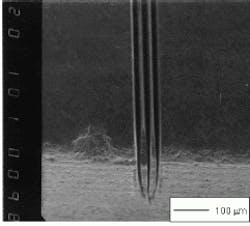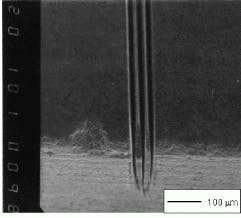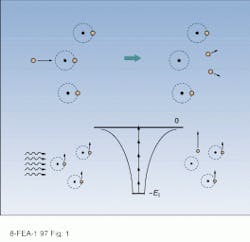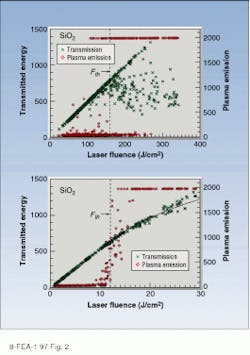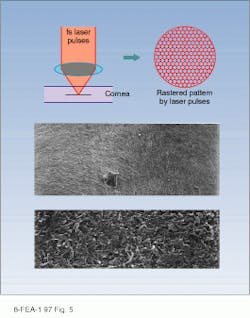Ultrashort laser pulses tackle precision machining
Ultrashort laser pulses tackle precision machining
The nature of ultrashort pulse interaction with matter permits ultrafast lasers to beat the
diffraction limit--cutting and drilling materials with feature sizes
smaller than the
wavelength of light.
Xinbing Liu and Gerard Mourou
Industrial laser material processing uses spatially and temporally concentrated laser energy for ablating, drilling, cutting, welding, and other modifications of the material. The laser has firmly established itself as an indispensable industrial tool, and new applications of lasers in industry are being developed at a rapid pace. One branch of laser material processing is laser micromachining, which generally includes machining with feature sizes less than 100 µm.
Laser micromachining with excimer lasers has enjoyed much success in recent years. Excimer lasers, through their short ultraviolet (UV) wavelength and primarily photochemical interaction with the target material, can achieve very fine feature sizes. However, the excimer laser has some drawbacks. Its UV wavelength cannot penetrate a large class of transparent materials, including some glasses and plastics. The corrosive gases in the laser can make handling difficult. And for deep-UV excimer lasers, such as the argon fluoride (193 nm), radiation damage to optics is a problem. These factors can make the excimer laser unsuitable in many industrial applications.
Photons, unlike charged particles such as electrons that repel each other, allow themselves to be packed together extremely tightly. A packed bunch of photons forms an electromagnetic pulse. The shortest man-made pulses are generated with ultrafast lasers. These ultrashort pulses offer an inexpensive way to obtain very high peak powers (and hence very high peak laser intensities) with low pulse energies. For example, a laser pulse with a pulse width of 100 fs (10-13 s) and a pulse energy of only 0.33 mJ has a peak intensity of
1015 W/cm2 when focused to a 20-µm-diameter spot. A 10-ns-long laser pulse would have to have 100 J in the pulse to reach the same intensity.
In some aspects, the ultrashort pulse duration fundamentally changes the mechanisms of laser-matter interaction. Short duration also means that the hydrodynamic motion of the matter under laser irradiation can be ignored, and there are essentially no fluid dynamics to consider during laser-matter interaction. Energy deposition takes place at the solid density, in contrast to the long-pulse case in which absorption mainly happens at the critical plasma density layer. However, the interaction is highly non-equilibrium, with electrons driven to much higher temperatures than the ions. Subsequent electron-ion energy relaxation takes place on a much longer time scale than the laser-matter interaction time.
Chirped-pulse amplification has made available ultrashort-pulse laser systems for investigations in industrial laser applications for some time.1 As we attempt to apply ultrashort pulses to laser machining and clarify the unique characteristics of ultrashort-pulse laser-matter interaction, we realize that ultrashort pulses are best applied in high-precision laser ablation of materials (see photo,
p. 101). Ultrashort-pulse laser micromachining in the visible and near-infrared regions shares some of the characteristics of excimer lasers. The development of ultrashort-pulse laser micromachining may provide a competitive alternative to excimer lasers in some applications, in addition to other applications unsuitable for excimer lasers. New laser technology will have to be developed and existing techniques made more rugged before ultrafast lasers make a large inroad into the industrial market (see "The industrial challenge for ultrafast lasers," below).
Ablation with ultrashort laser pulses
Laser micromachining, specifically drilling and cutting, involves removal of materials through the ablation process; the target material absorbs laser energy and is transformed into either a liquid or a vapor. The melted liquid is expelled from the interaction region--the laser focus--by a recoil action, and the vapor removes itself directly from the focus. The absorption of laser energy by the target material is accomplished by either linear or nonlinear processes. The material in the focal region is heated to melting temperature and, depending on laser intensity and pulsewidth, subsequently to vaporization temperature. At non-UV wavelengths, different absorption mechanisms govern absorbing materials such as metals and semiconductors and transparent dielectric materials such as glasses and plastics. In transparent materials, absorption has to come from nonlinear processes through laser-induced optical breakdown, initiated by avalanche and multiphoton ionization.
In a transparent dielectric material, the bound valence electrons have an ionization potential or bandgap greater than the laser photon energy (see Fig. 1). Bound electrons do not absorb laser light at low intensities. However, in real, or normal, materials there are always some free or conduction electrons present, and they are the seed electrons for avalanche ionization. A free electron, when simply wiggling in the oscillating laser field, does not gain energy when averaged over an optical cycle, thus it does not absorb the laser energy. However, the free electron can absorb laser energy when it collides with the bound electrons and the lattice through dephasing. The seed electron can be accelerated enough to raise its kinetic energy above the ionization potential of the bound electron. The next collision with a bound electron will result in an ionization event if the free electron transfers nearly all its energy to the bound electron, resulting in two free electrons with low kinetic energies.
This process will repeat itself, leading to an avalanche in which the free-electron density grows exponentially. When enough bound electrons are ionized by this avalanche process, a plasma with a critical density is created, and the transparent material is broken down and becomes absorbing. Laser-induced breakdown is accompanied by emission of acoustic waves and optical plasma radiation (a spark) from the focus.
At high field strengths, multiphoton ionization is the process by which a bound electron in an atom absorbs m photons simultaneously to become ionized. As this is an m-th order process, the cross section is extremely small. Only at very high field strength is multiphoton ionization significant. Therefore, for long pulsewidths, the multiphoton ionization contribution is negligible, and the laser-induced breakdown is dominated by avalanche ionization. At ultrashort pulsewidths, however, multiphoton ionization plays an important role: it determines the breakdown threshold behavior.
Crossing breakdown threshold
The threshold of laser-induced breakdown is customarily expressed as a laser fluence threshold (in unit of energy per unit area) as a function of pulsewidth. For pulsewidths from CW down to a few tens of picoseconds, the breakdown mechanism is the avalanche ionization, started from the initial seed electrons. The fluence breakdown threshold for this pulsewidth regime scales roughly as the square root of the pulsewidth. Recently, some work on breakdown threshold for ultrashort pulsewidths has shown deviation.2,3
More important, the large statistical variation of breakdown events near the threshold at long pulsewidths has disappeared at ultrashort pulses (see
Fig. 2). The breakdown fluence threshold is defined as the fluence at which there is a 50% probability a laser pulse with this fluence will cause breakdown. For long pulses the threshold has a large deviation: some pulses with fluences way below the threshold value can cause breakdown, while other pulses with fluences far above the threshold will not cause breakdown. However, the situation changes drastically when ultrashort laser pulses are used: the deviation in breakdown threshold is confined to a very narrow range. The behavior of the breakdown threshold changes from a statistical nature to a deterministic one.
The difference in breakdown behavior of long and short pulses indicates that different physical mechanisms are involved at ultrashort pulsewidths. The large statistical scatter for long pulses is mainly attributed to the statistical variation of the seed electrons. For a normal material the seed-electron density due to impurities can be in the range of 108-1010 cm-3. The volume of the laser focus of a 10-µm spot is on the order of 10-9 cm3. Therefore, the number of seed electrons in this volume can be on the order of unity, and, microscopically, the actual number of seed electrons can vary greatly from site to site. The avalanche ionization that leads to breakdown for long pulses thus will exhibit large fluctuations, because the seed electrons come only from those that are already present.
For ultrashort pulses with very high field strength, multiphoton ionization can directly generate free electrons; they do not need to rely on the impurities in seed electrons. Down to approximately 100 fs, the role of multiphoton ionization in the breakdown process is to supply the seed electrons. Breakdown is still completed by the avalanche ionization. In this case, however, the seed-electron density can be quite high and does not exhibit large statistical fluctuation. Consequently, the breakdown threshold becomes precise at ultrashort pulsewidths.
Once the plasma of free electrons generated by avalanche ionization reaches a high-enough density, irreversible material breakdown and ablation begin. Electrons absorb laser energy by collisions with ions and are heated to high temperatures; at the same time, the electrons transfer energy to the ions and the lattice, and the material is heated up. The amount of energy transfer, hence the rate of heating, during the laser pulse depends on the pulse duration and the energy coupling coefficient. Absorbed energy also leaves the laser focal volume by heat conduction; therefore a larger volume than the focus is heated.
For long pulses the energy transfer from electrons to ions during laser-matter interaction is strong, and the heat diffusion can involve a much larger volume than the focus. For CW-to-microsecond laser pulses, a large volume around the laser focus can be melted, but only a relatively small layer of material reaches vaporization temperature. As the pulsewidths decrease, the laser field strength increases, and the interaction time gets shorter. The electrons are driven to a much higher temperature, and the ion or lattice temperature is much lower than the electron peak temperature. The electron temperature can reach tens of electron volts
(1 eV = 11,600 K) during the laser pulse duration, while the ions remain relatively cold. Subsequent electron-ion energy transfer, mostly taking place after the laser pulse is over, will then heat the ions to much higher temperatures compared to the long-pulse cases. A large fraction of the material in the interaction volume is vaporized, going through a melt phase very quickly. The heat-affected volume due to conduction is much smaller because of the short interaction time. For ultrashort pulses it can actually become smaller than the focus when the laser fluence is at or just above the threshold value.
For absorbing materials, such as metals and semiconductors, there is a large density of free electrons and valence electrons with an ionization potential less than the photon energy. For long pulses the linear absorption dominates, and the material is heated through joule heating. When melting or vaporization temperature is reached, the material is considered broken down and damaged. The rate of heating is determined by the rate of laser energy absorption and the rate of energy loss from the focus, mainly through thermal conduction away from the focus.
The rate of laser energy absorption is approximately constant before the breakdown, and the energy is deposited in a surface layer whose thickness is given by the absorption or penetration skin depth. For long pulses, then, the fluence breakdown threshold varies with laser pulsewidth, but, as the laser pulsewidth decreases, the skin depth determines the heated volume during the laser pulse, not the heat-penetration depth. The breakdown threshold becomes independent of the pulsewidth.
For long pulses, in which heat diffusion length is larger than the skin depth, a large volume is heated and melted, and ablation and material removal are accomplished through the melt expulsion driven by the vapor pressure and the recoil of the light pressure. This process is very unstable because the dynamics of the fluid phase and the driving vapor conditions are quite complicated. The resolidification of the melt (recast layer) after ablation can lead to very irregular shapes in holes and cuts.
For ultrashort pulses, however, the deposited laser energy is limited and the localized energy heats the material very quickly past the liquid phase to the vapor phase with high kinetic energy. Material removal is by direct vaporization away from the surface; most is accomplished after the laser pulse is gone. The material is still heated by diffusion over a longer time scale, but the resulting melt layer thickness will be small because a large fraction of heated material reaches vaporization temperature and because of the rapid cooling, both due to the steep temperature gradient. The heating of the material is further reduced by the large amount of absorbed laser energy carried away by direct vaporization. Because little liquid is involved, ablation and material removal become highly precise, in contrast to the long-pulse case.
Micromachining with ultrashort pulses
Because laser-induced breakdown threshold can be determined with great precision, we can control the input intensity profile of the laser beam so that only a small portion of the focused laser spot is above the ablation threshold. We then can machine spot sizes with diameters smaller than the laser spot size, due to the nonspreading nature of this affected volume (see Fig. 3).
In other work, 0.3-µm holes were drilled in silver films using 200-fs Ti:sapphire laser pulses focused to a
3-µm diameter.4 In both cases the focused laser fluences were controlled to just above the ablation threshold. Therefore the feature size is not limited by the spot size, or even by the wavelength, when ultrafast pulses are used. Taking advantage of high precision and the transparency of glasses to the near-infrared wavelength, researchers have recently demonstrated three-dimensional optical storage with a density exceeding 1010 bit/cm3 inside glasses using
780-nm femtosecond pulses;5 they calculated a theoretical limit on the order of 1013 bit/cm3.
Short and long pulses give dramatically different results (see Fig. 4). The sample was 0.002-in.-thick polyethylene terephthalate (PET) film, a transparent polymeric material. Two pulsewidths from a Ti:sapphire CPA laser working at 1-kHz repetition rate were used: 80 fs and 200 ps. Because the same laser system was used, the focusing property and the pulse-to-pulse energy fluctuations were the same for both pulsewidths. The sample was translated at constant linear speeds for single-shot ablation. The experimentally determined ablation threshold for the 200-ps pulsewidth,
~8 J/cm2, is a factor of five higher than the threshold for 80-fs pulses.
Images from an optical microscope show that the 80-fs pulses produced clean, uniform holes and cuts. In contrast, 200-ps pulses produced very uneven results. Near the threshold some shots produced ablation; others did not. This is a visual representation of the statistical and deterministic behavior of the ultrashort and longer pulse breakdown threshold--note that 200 ps is not "long pulse`` at all--as shown in Fig. 2. Also the affected volume is much larger at sites where long pulses produced ablation; cracking of the material was evident. Because the fluence threshold is much higher for 200-ps pulses than for 80-fs pulses, once the breakdown is initiated, more energy is absorbed and spread in the material, and the high heat load causes the substrate to crack.
With ultrashort pulses, the micromachined spot size is no longer limited by the spot size, hence the wavelength. The machined feature size--the size of the transition layer between machined part and unaffected substrate--can be even smaller. Therefore ultrafast lasers may provide an alternative to excimer lasers for some applications. One possible application is the laser etching of integrated circuits, where submicrometer lines are required. Most current CPA ultrafast lasers operate in the 0.75-1-µm near-infrared range, however. With frequency conversion techniques such as harmonic generation and optical parametric amplification, visible and UV-wavelength ultrashort laser pulses can be produced. The combination of ultrashort pulses and short wavelength may prove a powerful tool for a host of ultrafine micromachining applications--nanofabrication may be possible.
The same high-precision results can be obtained on biological tissue as well. Internal laser ablation--or photodisruption--of ocular tissue with ultrashort pulses can be used to perform delicate laser surgery unattainable with long pulses or other means. In one such procedure, the goal is to cut a plane in the cornea to make a flap. The purpose of the flap is to allow excimer laser access to the internal tissue (stroma) of the cornea, instead of the superficial layer, for refractive surgery to correct myopia.
The femtosecond beam is focused into the cornea at a certain depth with a fast lens. A pulse with a pulse energy
~1 µJ is delivered to the focus. The tissue in the focus is vaporized by absorbing the laser energy through laser-induced breakdown, forming a cavitation bubble and leaving a small void. By rastering the beam inside the cornea and creating voids connecting to each other, a plane is created separating the top and bottom layers (see Fig. 5). After a side cut to the top surface is made, the flap can be lifted off using a pair of tweezers. Femtosecond pulses are necessary for high accuracy, minimal collateral tissue damage due to shock waves, and minimal heat effects due to reduced pulse energy. Long pulses cannot be used for this procedure because of lack of control of laser-induced breakdown in the long-pulsewidth range. When long-pulse breakdown does occur in corneal tissue, significant collateral damage would occur, similar to that seen in Fig. 4.
The flap surface created by femtosecond pulses is quite smooth, compared to the flap surface cut by the knife in a device called a microkeratome, which is currently used clinically. The improvement in surface quality obtained with femtosecond pulses can translate into better results for the refractive surgical procedure. Ultimately, refractive surgical procedures performed entirely with femtosecond pulses may be realized. o
REFERENCES
1. D. Strickland and G. Mourou, Opt. Commun. 56, 219 (1985).
2. D. Du et al., Appl. Phys. Lett. 64, 3071 (1994).
3. B. C. Stuart et al., Phys. Rev. Lett. 74, 2248 (1995).
4. P. Pronko et al., Opt. Commun. 114, 106 (1995).
5. E. N. Glezer et al., Opt. Lett. 21, 2023 (1996).
Cuts made in high-density graphite sample illustrate efficacy of ultrashort pulses used for high-precision laser ablation of industrial materials. The center-to-center distance between cuts is 28 µm.
FIGURE 1. In electron avalanche by collisional impact ionization,
secondary free electrons are generated during collisions with electrons whose kinetic energy is greater than the bound electron binding energy (top). In the multiphoton ionization process, a bound electron is ionized by simultaneously absorbing m photons.
FIGURE 2. Single-shot plasma emission data of laser-induced breakdown in fused silica show wide variance between laser pulse widths of 7 ns (top) and 170 fs (bottom).
FIGURE 3. Intensity profile
of laser focus spot can be controlled so that only a small portion near the center is above the breakdown threshold (top). A Ti:sapphire laser at 790 nm with 60-fs pulses and focused laser spot size of 5-µm diameter drilled holes of <1-µm diameter in fused silica sample (bottom). Hole depth, as measured by the confocal microscope, is 10-15 µm. Laser fluence was at the breakdown threshold
(~10 J/cm2).
FIGURE 4. Pulsewidth dramatically affects micromachining of PET plastic. With 80-fs pulses, sample was translated at 20 mm/s (the spots` center-to-center distance is 20 µm) at 5 µJ/pulse (a) and
8 mm/s at 5 µJ (b). With 200-ps pulses, the sample was translated at 15 mm/s at 20 µJ (c) and 20 mm/s at 150 µJ (d). The laser wavelength was 800 nm, and the spot size was 19 µm full width at 1/e2 points.
FIGURE 5. Femtosecond laser pulses can cut a fla¥in the eye`s cornea (to¥and middle) that is smoother than the surface of a fla¥cut by a mechanical microkeratome (bottom).
The industrial challenge for ultrafast lasers
Ultrafast lasers, or laser systems that produce ultrashort laser pulses, are relative newcomers to the laser industry. The technology of generating and amplifying ultrashort-duration laser pulses has only been developed in the past ten years or so. Almost all amplified laser systems are based on the chirped-pulse amplification (CPA) technique. Direct amplification of ultrashort pulses to power levels useful for micromachining and other applications usually runs into the problem of optical damage to the components of the laser system. Chirped-pulse amplification circumvents this problem by lowering the power prior to amplification.
There are four basic elements in a CPA system: ultrafast oscillator, pulse stretcher, amplifier, and pulse compressor. Because a CPA system involves pulsewidth manipulation, it is quite complicated and different from CW and long-pulse laser systems. Specialized laser technical know-how and competence are needed to operate and maintain such a laser system. As an example, consider the regeneratively amplified, kilohertz-repetition-rate Ti:sapphire CPA laser, with which all of the examples we describe in the main article were performed.
The pum¥lasers for the ultrafast oscillator and the amplifier are large-frame argon-ion lasers or flashlamp-pumped, frequency-doubled Nd:YAG lasers. These cumbersome lasers bring size, stability, and reliability problems. The alignment tolerances of the stretcher and compressor are quite stringent to ensure pulsewidth and beam quality. It is impractical for such a laser to be used in an industrial manufacturing environment, and, until now, its size has been one reason why the CPA-ultrafast laser has remained exclusively a scientific laboratory tool. Most Ti:sapphire lasers have an average output power of approximately 1 W. Both currently available average power levels and system complexity have kept ultrafast lasers from being used in industry.
However, the rapid developments in diode-pumped, all-solid-state laser technology have brightened the prospect of bringing ultrafast laser technology to practical industrial use. Using recently developed high-power diode lasers as pum¥sources, researchers have demonstrated stable, solid-state generation of amplified femtosecond laser pulses.1 It is more likely that a low-cost, compact, rugged turn-key ultrafast laser system intended for industrial applications can be designed and produced. We believe that the immediate goal for an industrial-class ultrafast laser will be a 10-W average power level CPA laser.
Ultrafast laser gain materials suitable for direct diode pumping include Nd:glass, Yb:glass, Yb:YAG, and Cr:LiSAF. We think Yb-doped gain materials will prove to be especially important for industrial ultrafast lasers. The rediscovery of Yb-doped laser materials such as Yb:YAG and Yb:glass for ultrafast laser applications makes them ideal potential candidates for high-average-power ultrafast lasers. The Yb3+ ion has a broad emission bandwidth that can support femtosecond laser pulses. It has very high saturation fluences and therefore excellent energy storage capability. More important, Yb-doped laser materials can be efficiently diode-laser-pumped in the 900-980-nm band, where inexpensive high-power diode lasers are available.
Recent advances in all-solid-state, diode-laser-pumped lasers offer great hope for a new generation of rugged and compact industrial lasers based on Yb-doped materials.2 Other aspects of the CPA ultrafast laser system, such as compact, easy-to-align pulse stretchers and compressors, need to be developed as well.
X. L. and G. M.
REFERENCES
1. A. Braun et al., Appl. Opt. 36, 4163 (1997).
2. J. Machan et al., J. Laser Appl. 8, 225 (1996).
XINBING LIU is assistant research scientist and GÉRARD MOUROU is director of the Center for Ultrafast Optical Science (CUOS), the University of Michigan, 2200 Bonisteel Blvd., Room 1006, Ann Arbor, MI 48109-2099.
